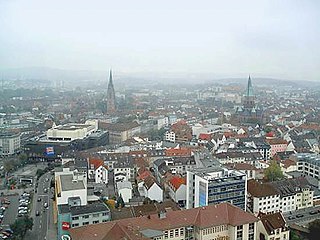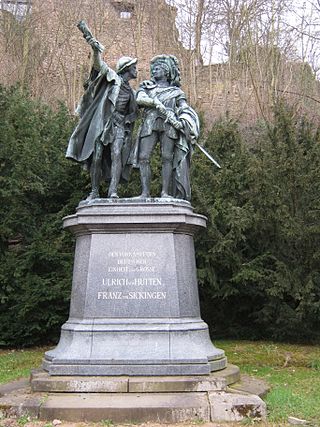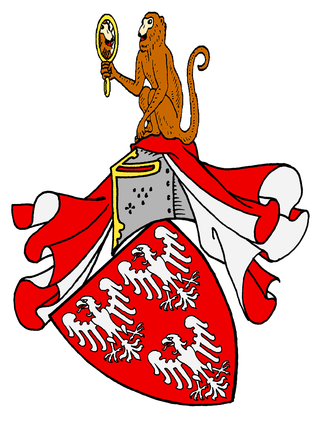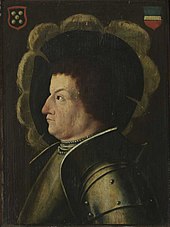
Franz von Sickingen was a knight of the Holy Roman Empire who, with Ulrich von Hutten, led the so-called "Knights' War," and was one of the most notable figures of the early period of the Protestant Reformation. Sickingen is posthumously known as "the last knight", an epithet he shared with his contemporaries Chevalier de Bayard and Emperor Maximilian.

Kaiserslautern is a town in southwest Germany, located in the state of Rhineland-Palatinate at the edge of the Palatinate Forest. The historic centre dates to the 9th century. It is 459 kilometres from Paris, 117 km from Frankfurt am Main, 666 kilometers from Berlin, and 159 km from Luxembourg.

Eltz Castle is a medieval castle nestled in the hills above the Moselle between Koblenz and Trier, Germany. It is still owned by a branch of House of Eltz who have lived there since the 12th century. Eltz Castle along with Bürresheim Castle and Lissingen Castle are the only castles in the Eifel region which have never been destroyed.

Bad Münster am Stein-Ebernburg is a spa town of about 4,000 inhabitants in the Bad Kreuznach district in Rhineland-Palatinate, Germany. Since 1 July 2014, it is part of the town Bad Kreuznach. It was the seat of the former like-named Verbandsgemeinde, but not part of it. Bad Münster am Stein-Ebernburg was granted town rights on 29 April 1978 and is recognized as a mineral spring spa (Mineralheilbad) and a climatic spa. Today the "Spa" is famous for its clinics specializing in cardiological and orthopaedic rehabilitation. The many graduation towers form the largest open air inhalatorium in Europe.

The Knights' War, also known as the Imperial Knights' Revolt, was a failed attempt by the Brotherly Convention led by the Evangelical knight Franz von Sickingen to forcibly remove Prince-bishop Richard of Trier and secularize his lands. The short-lived war resulted in the death of Sickingen and inspired the German Peasants' War of 1524–1526.

Landstuhl, officially the Sickingen Town of Landstuhl, is a town in the Kaiserslautern district of Rhineland-Palatinate in Germany. It is the seat of the Municipal Association of Landstuhl. Situated on the north-west edge of the Palatinate Forest, 11 miles (18 km) west of the city of Kaiserslautern, the town is located near Ramstein Air Base.

Blieskastel is a city in the Saarpfalz (Saar-Palatinate) district, in Saarland, Germany which is divided into villages. It is situated on the river Blies, approximately 10 kilometres southwest of Homburg (Saar), 8 km (5 mi) west of Zweibrücken, and 20 km (12 mi) east of Saarbrücken.

The Electorate of Trier was an ecclesiastical principality of the Holy Roman Empire that existed from the end of the 9th to the early 19th century. It was the temporal possession of the prince-archbishop of Trier who was, ex officio, a prince-elector of the empire. The other ecclesiastical electors were the electors of Cologne and Mainz.

Wiesbach is a municipality in Südwestpfalz district, in Rhineland-Palatinate, in the southwest of Germany. The place name is composed of the two German words for meadow and brook.

Hallgarten is an Ortsgemeinde – a municipality belonging to a Verbandsgemeinde, a kind of collective municipality – in the Bad Kreuznach district in Rhineland-Palatinate, Germany. It belongs to the Verbandsgemeinde of Bad Kreuznach, whose seat is in the like-named town. Hallgarten is a state-recognized tourism community.

Drachenfels Castle is a ruined hill castle near the village of Busenberg in the state of Rhineland-Palatinate. It lies within the German half of the Wasgau region, the southern part of the Palatinate Forest.

Berwartstein Castle is a castle in the Wasgau, the southern part of the Palatinate Forest in the state Rhineland-Palatinate in southwestern Germany. It was one of the rock castles that were part of defences of the Palatinate during the Middle Ages. This castle is noted in the publication Works of Preservation of Monuments of Rheinland-Pfalz, which was assembled and edited for the Ministry of Education and Culture. This states that the three prime examples of rock castles in the region are Drachenfels, Altdahn and Berwartstein, castles where the stairs, passages and rooms are carved out of the rock to form part of the accommodation essential to the defence of the castle. Although the Berwartstein appears more complete when compared to the ruins of neighbouring castles, it is only a restoration of the original rock castle. It is the only castle in the Palatinate that was rebuilt and re-inhabited after its demolition.

Spangenberg Castle is the partially rebuilt ruin of a rock castle in the German state of Rhineland-Palatinate. It lies in the Palatine Forest above the Elmstein valley near the village of Erfenstein, but is actually on the forest estates belong to the town of Neustadt an der Weinstraße, or more precisely, the village of Lachen-Speyerdorf. Together with the neighbouring castle of Erfenstein, it is linked to the legend of the Leather Bridge.
A Lehnsmann or Lehnsnehmer was a nobleman in the Middle Ages in German-speaking countries, who, as a liegeman was obliged to render service, goods in kind and loyalty to another nobleman, his liege lord (Lehnsherr), in return for which he was rewarded either by a grant of land, which included the population living within it, or by receiving an office. A distinction was made between the gift and the inheritable fee.

Tanstein Castle is the ruin of a rock castle in the southern Palatine Forest, the German part of the Wasgau region. It lies just under a kilometre east of the small town of Dahn in the state of Rhineland-Palatinate.

The Dahn family, also Tan, Tann or Thann, is a German noble family from the Palatinate region of Germany.

The Sickingen Heights form a landscape in the western part of the German state of Rhineland-Palatinate. The region was named after the family of imperial knight, Franz von Sickingen (1481–1523), because most of the area belonged to the territory of the House of Sickingen in the Middle Ages.

The House of Sickingen is an old southwest German noble family. The lords of Sickingen belonged to the Kraichgau nobility and from 1797 to the Imperial nobility. Significant relatives emerged from the family, who achieved great influence in both spiritual and secular offices. Reinhard von Sickingen was Prince-Bishop of Worms from 1445 to 1482 and Kasimir Anton von Sickingen was Prince-Bishop of Constance from 1743 to 1750. Imperial Knight Franz von Sickingen (1481-1523) was a leader of the Rhenish and Swabian knighthood.

Hohenecken Castle is the ruin of a spur castle from the Hohenstaufen era on the Schlossberg hill above the Kaiserslautern ward of Hohenecken in Rhineland-Palatinate, Germany. It is located at an elevation of 363 m above sea level (NN).

The Ehrenburg is the ruin of a spur castle at 230 m above sea level (NN) in the vicinity of Brodenbach in Germany. The castle had a very eventful history. It was built on a rocky spur called the Ehrenberg situated above the valley of the Ehrbach, a right bank valley of the Moselle. Once the fortified heart of a small imperial barony with estates between the Lower Moselle and Middle Rhine, it is today a cultural monument that hosts numerous events.




















